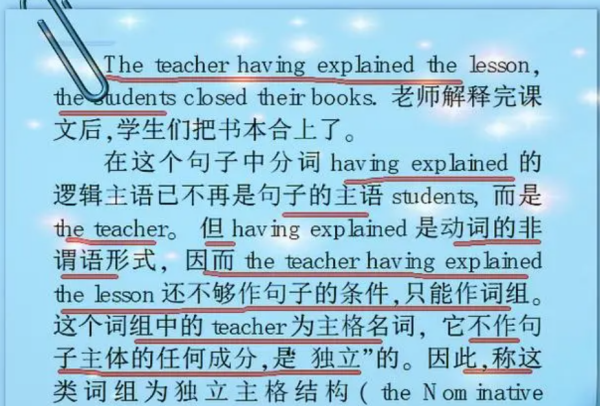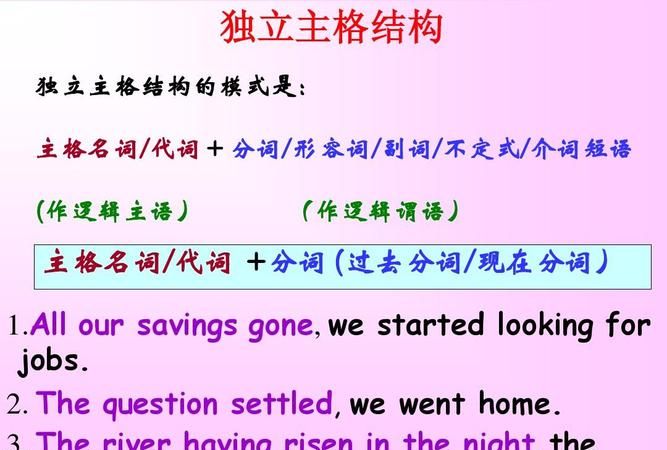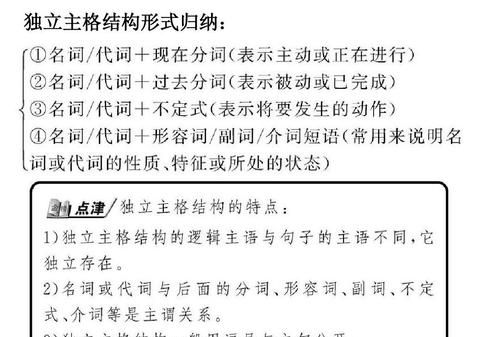本文目录
英语独立主格结构是什么
(一):独立主格的概念
“独立主格结构”是由名词或代词作为逻辑主语,加上分词、形容词、副词、动词不定式或介词短语作为逻辑谓语构成。这种结构在形式上与主句没有关系,通常称为“独立主格结构”。
(二):独立主格的功能
“独立主格结构”实质就是带有自己主语的非限定状语从句。众所周知非限定性从句通常以主句的某一成分作为自己的逻辑主语,从而依附于主句。而有些非限定性从句和无动词从句带有自己的主语,在结构上与主句不发生关系,因此成为独立主格结构。其实,虽然叫做独立主格结构,并不是真正的独立,它还是一种从属分句,在句中有多种作用。如:表原因、表条件、表方式、表伴随、表时间等,在句中通常起状语作用。
独立主格结构主要用于描绘性文字中,其作用相当于一个状语从句,常用来表示时间、原因、条件、行为方式或伴随情况等。例如:
1) 表示时间
The meeting being over, all of us went home. 开完会后我们都回家了。
Her work done, she sat down for a cup of tea. 她干完了活,坐下来喝茶。
2) 表示条件
The condition being favourable, he may succeed. 若条件有利,他或许能成功。
3) 表示原因
There being no taxis, we had to walk. 没有出租车,我们只好步行。
He wrapped her up with great care, the night being dark and frosty. 夜又黑又冷,所以他把她裹得严严实实的。
4) 表示伴随情况
Almost all metals are good conductors, silver being the best of all. 几乎所有的金属都是良导体,而银则是最好的导体。(=Almost all metals are good conductors,
and silver is the best of all.)
(三): 独立主格结构的构成:
名词(代词)+现在分词、过去分词;
名词(代词)+形容词;
名词(代词)+副词;
名词(代词)+名词
名词(代词)+不定式;
名词(代词) +介词短语构成。
(四) 独立主格结构的特点:
(1)独立主格结构的逻辑主语与句子的主语不同,它独立存在。
2)名词或代词与后面的分词,形容词,副词,不定式,介词等是主谓关系。
3)独立主格结构一般有逗号与主句分开。
举例:(一)
1) 名词/代词+形容词
The men moved slowly forward, neck deep in the water, with their officers guiding them.
It stood silent in the noon sunlight, its door open.
2) 名词/代词+现在分词
Winter coming, it gets colder and colder. 冬天来了,天气越来越冷了。
The rain having stopped, he went out for a walk. 雨停了,他出去散步。
The question being settled, we wound up the meeting. 问题解决之后,我们结束了会议。
3) 名词/代词+过去分词
“Marquis,” said the boy, turning to the man, his eyes opened wide, and his right hand raised.
4) 名词/代词(主格)+不定式
We shall assemble at ten forty-five, the procession to start moving at precisely eleven. 我们十点四十五分集合,队伍十一点准时出发。
Here are the first two volumes, the third one to come out next month. 这是前两卷,第三卷将于下月问世。
We divided the work, he to clean the windows and I to sweep the floor. 我们进行了分工,他擦窗户,我扫地。
The two boys said good-bye to each other, one to go home, the other to go to his friend’s. 两个男孩彼此道了别,一个回了家,另一个去了他朋友家。
5) 名词/代词+介词短语
I followed him here, climbed in, sword in hand.
The huntsman entered the forest, gun in hand. 那位猎人手里提着枪走进了树林。
He sat at the table, coat off, head down, and pen in hand.
6) 名词/代词+副词
Nobody in, the thief took a lot of things away.
Lunch over, he left the house. But he was thinking.
7) 名词/代词+名词
he fought the wolf, a stick his only weapon. 他和狼搏斗着,唯一的武器是一根棍棒。

英语独立主格结构
非谓语动词作状语时,它的逻辑主语应该是句子的主语。但有时非谓语动词带有自己的主语,从而在结构上与主语不发生关系,我们称之为独立主格结构(Absolute Construction)。其实,所谓“独立主格结构”也并非真正独立,它还是一种从属的结构。

一、非谓语动词独立主格结构
在独立主格结构中,非谓语动词和它前面的名词或代词存在着逻辑上的主谓关系。
Such an able man to help you,you will surely succeed sooner or later.
有这么能干的人来帮你,你迟早一定会成功的。(such an able man和to help you之间存在着主谓关系)
= Since such an able man will help you, you will surely succeed sooner or later.
He seating himself at the desk, his mother began to tell him a story.
他在书桌旁坐好后,他母亲开始给他讲故事。(seating himself at the desk拥有了自己的逻辑主语he,注意是“主格”)
= When he seated himself at the desk, his mother began to tell him a story.
The key to the bike lost, he had to walk to school.
由于丢了自行车钥匙,他只好步行去学校。(lost的逻辑主语是the key,lost也可以用完成式having been lost)
= Because the key to the bike had been lost, he had to walk to school.
A.不定式“独立主格结构”
在“逻辑主语+动词不定式”结构中,动词不定式和它前面的名词或代词存在着逻辑上的主谓关系。这种结构也可用一个从句或并列分句来表达。

英语中的独立主格结构是什么意思
编辑本段独立主格结构(Independent Genitive)
独立主格结构有两部分组成,前一部份是名词或者代词,后一部分是非谓语动词或其他的一些词。前后两部分具有逻辑主谓关系。独立主格结构在句中做状语,多用于书面语。
独立主格结构本身不是句子,在句子中作状语,表示时间、原因、条件、伴随等。
常见的独立主格结构有如下几种:
1. 名词/主格代词+现在分词。名词/主格代词与现在分词之间主谓关系。如:
The girl staring at him (= As the girl stared at him), he didn”t know what to say. 姑娘两眼望着他,他不知道说什么好。
Time permitting (= If time permits), we will go for an outing tomorrow. 如果时间允许的话,我们明天去郊游。
2. 名词/主格代词+过去分词。名词/主格代词与过去分词之间的动宾关系。如:
The problems solved (= As the problems were solved), the quality has been improved. 随着问题的解决,质量已经提高了。
Her glasses broken (= Because her glasses were broken), she couldn”t see the words on the blackboard. 由于眼镜摔坏了,她看不见黑板上的字。
3. 名词/主格代词+不定式。名词/主格代词与不定式之间是主谓关系,且强调的是一次具体性的动作。如:
He is going to make a model plane, some old parts to help. 借助于一些旧零件,他要做一个飞机模型。
They said good-bye to each other, one to go home, the other to go to the bookstore. 他们道别后,一个回了家,一个去了书店。
4. 名词/主格代词+形容词。如:
An air accident happened to the plane, nobody alive. 那架飞机遭遇了空难,无一人生还。
So many people absent, the meeting had to be called off. 这么多人缺席,会议不得不取消。
5. 名词/主格代词+副词。如:
He put on his sweater wrong side out. 他把毛衣穿反了。
The meeting over, they all went home. 会议一结束,他们就都回家了。
6. 名词/主格代词+介词短语。如:
The boy goes to the classroom, book in hand. 那男孩手里拿着书去教室。
Mary was sitting near the fire, her back towards the door. 玛丽靠近火炉坐着,背对着门。
7. There being +名词(代词)如:
There being nothing else to do, we went home. 没有别的事可做,我们就回家了。
There being no further business, I declare the meeting closed. 没有再要讨论的事了,我宣布散会。
8. It being +名词(代词)如:
It being Christmas, the government offices were closed. 由于圣诞节的缘故,政府机关都休息。
It being a holiday, all the shops were shut. 由于今天是假日,所有商店都关门了。
独立主格结构的特点:
1)独立主格结构的逻辑主语与句子的主语不同,它独立存在。
2)名词或代词与后面的分词,形容词,副词,不定 式,介词等是主谓关系。
3)独立主格结构一般有逗号与主句分开。
举例:
The test finished, we began our holiday.
= When the test was finished, we began our holiday.
考试结束了,我们开始放假。
The president assassinated, the whole country was in deep sorrow.
= After the president was assassinated, the whole country was in deep sorrow.
总统被谋杀了,举国上下沉浸在悲哀之中。
Weather permitting, we are going to visit you tomorrow.
如果天气允许,我们明天去看你。
This done, we went home.
工作完成后,我们才回家。
The meeting gone over, everyone tired to go home earlier.
会议结束后,每个人都想早点回家。
He came into the room, his ears red with cold.
他回到了房子里,耳朵冻坏了。
He came out of the library, a large book under his arm.
他夹着本厚书,走出了图书馆
注:独立主格结构有时可在其前加上介词with。
如:Don’t sleep with the windows open. 别开着窗睡觉。
He was lying on the bed with all his clothes on. 他和衣躺在床上。
She came in with a book in her hand. 她手里拿着一本书走了进来。
He fell asleep with the lamp burning. 他没熄灯就睡着了。
I won’t be able to go on holiday with my mother being ill. 因为妈妈有病,我无法去度假。
He sat there with his eyes closed. 他闭目坐在那儿。
All the afternoon he worked with the door locked. 整个下午他都锁着门在房里工作。
I can’t go out with all these clothes to wash. 要洗这些衣服,我无法出去了。
使用独立主格五点注意:
1.独立主格与状语从句的转换当状语从句的主语与主句的主语不是指同一个对象时,可用独立主格结构取代状语从句,但不再保留连词。如:After class was over (=Class being over / Class over), the students soon left the classroom.下课后,学生很快离开了课室。
2. 不能省略being (having been)的情形在下列两种情况下,独立主格结构中的being(或having been)不能省略。
(1) 独立主格的逻辑主语是代词时。如:It being Sunday, we went to church.因为是星期天,我们去了做礼拜。
(2)在There being+名词的结构中。如:There being no bus, we had to go home on foot.因为没有公共汽车,所以我们不得不步行回家。
3. 通常不用物主代词或冠词在“名词(或代词)+介词短语”构成的独立主格结构中,一般不用形容词性物主代词和冠词。如: Miss Smith entered the classroom, book in hand.史密斯先生走进了课室,手里拿着一本书。比较with的复合结构。如:Miss Smith entered the classroom, with a book in his hand.
4. 独立主格结构没有所有格形式The chief-editor arriving, we began the meeting. 主编来主编来了,我们开始开会。(比较动名词复合结构。)
独立主格结构的用法
独立主格结构主要表示谓语动词发生的时间、原因、条件或伴随情况等,相当于一个状语从句或并列句。
1. 用作时间状语:The work done (=After the work had been done), we went home. 工作完成后,我们就回家了。
2. 用作条件状语:Weather permitting (=If weather permits), they will go on an outing to the beach tomorrow. 如果天气允许的话,他们将在明天组织一次海滨小游。
3. 用作原因状语:An important lecture to be given tomorrow (=As an important lecture will be given tomorrow), the professor has to stay up late into the night. 因为明天要发表一个重要的演讲,教授不得不熬夜到很晚。
4. 用作伴随状语:He was lying on the grass, his hands crossed under his head (=and his hands were crossed under his head).他躺在草地上,两手交叉枕在脑后。
5.表示补充说明:We redoubled our efforts, each man working like two. 我们加倍努力,一个人干两个人的活。
*注:独立主格结构表示时间、条件或原因时,相当于一个状语从句,一般放在句首,表示原因时还可放在句末;表伴随状况或补充说明时,相当于一个并列句,通常放于句末。
独立主格结构妙题赏析
请看下面一道题:
Not far from the school there was a garden, _________ owner seated in it playing chess with his little grandson every afternoon.
A. its B. whose C. which D. that
【分析】此题很容易误选B,许多同学会认为句中逗号后是一个非限制性的定语从句,whose 在定语从句中用作定语修饰其后的名词 owner。此分析从表面上看,似乎天衣无缝,但实质上是错的,原因是空格后根本不是一个句子,因为没有谓语。尽管句中有两个动词,但它们都是非谓语动词。也许有的同学认为,其中的 seated 可视为谓语动词,但是注意,seat 用作动词时,它总是及物的,其后要么接宾语,要么它就用于被动语态,所以若在 seated 前加上助动词 is,则可以选择B(当然若将 seated 改为sitting,也应选择B)。所以此题最佳答案选A。
请再看一个类似的例子:
(1) He wrote a lot of novels, many of _________ translated into foreign languages.
A. it B. them C. this D. that
(2) He wrote a lot of novels, many of _________ were translated into foreign languages.A. it B. them C. which D. that
第(1)应选B,而不能选C,是因为句中的 translated 是过去分词(非谓语动词),若选C,则该从句无谓语;第(2)应选C,因为句中有谓语 were translatedC。
再请看下面一例:
(3) He wrote a lot of novels, and many of _________ were translated into foreign languages.
A. it B. them C. which D. that
【分析】此题与上面的第(2)题不同,两句间多了一个并列连词and,说明这是一个并列句,故应选B,则不能选C。
请做做以下三题(答案均为B):
(1) There I met several people, two of _________ being foreigners.
A. which B. them C. whom D. that
(2) There I met several people, two of _________ were foreigners.
A. which B. whom C. who D. that
(3) There I met several people, and two of _________ were foreigners.
A. which B. them C. whom D. that

英语中独立主格结构是什么意思!
独立主格结构
独立主格结构是由一个相当于主语的名词或代词加上非谓语动词、形容词、副词或介词短语构成的一种独立主格成分。With( without) 的复合结构可以看作是独立主格结构中的一种形式。
一、独立主格结构的特点
1)独立主格结构的逻辑主语与句子的主语不同,它独立存在。
2)名词或代词与后面的分词,形容词,副词,不定式,介词等是主谓关系。
3)独立主格结构一般有逗号与主句分开。
The test finished, we began our holiday.
= When the test was finished, we began our holiday.
4) 当表示人体部位的词做逻辑主语时,及物动词用现在分词,不及物动词用过去分词
二、独立主格结构的构成:
名词普通格或代词主格 + 现在分词/过去分词/不定式/名词/形容词/副词/介词短语。
1.名词(或代词) + 现在分词
现在分词表示前面的名词或代词主动进行的动作或状态。
He seating himself at the desk, his mother began to tell him astory.
Everyone being ready, the teacher began his class.
The food being cooked, the boy was watching TV.
注意:现在分词being或having been在独立主格结构中可以省略。
The weather(being)fine, we decided to go on anouting.
独立主格结构中的being在下列两种情况下一般不能省略,
一是在“There being + 名词”结构中,
There being no bus, we had to walk home.
二是在逻辑主语是代词的情况下。
It being Sunday, all the offices are closed.
2.名词(或代词) + 不定式(短语)
不定式表示将来的动作。
He suggested going for a picnic, Mary to provide the food.
Many flowers and grass to be planted, our newly-built school willlook even more beautiful.
3.名词(或代词) + 过去分词
过去分词表示前面的名词或代词被动完成的动作。
The girls lay on her back, her hands crossed under her head.
The workers worked still harder, their living conditions greatlyimproved.
He was listening attentively in class, his eyes fixed on theblackboard.
4.名词(或代词) + 形容词(短语)
形容词(短语)在独立主格结构中说明前面名词或代词的性质、状态
The floor wet, we had to stay outside for a while.
He turned to me, his eyes sleepy.
5.名词(或代词) + 副词
副词在独立主格结构中也多是说明名词或代词的状态。
The meeting over, we all went home.
School over, we all went home.
6.名词(或代词) + 介词短语
A robber burst into the room, knife in hand.
He left the office, tears in eyes.
注意:在“逻辑主语+介词短语”构成的独立主格结构里,当介词是in时,其前后的两个名词均不加任何修饰成分。但with 的复合结构不受此限制。例如:Theteacher came in, with a book in hishand.
三、独立主格结构的作用:多用作状语
1.表示时间
His homework done(=After hishomework was done),
Mary decided to go shopping.
2.表示原因
There being no buses(=Because therewere no buses),we had to walk home.
3.表示条件
Weather permitting(=If weatherpermits),we’ll go to play basketball.
4.表示方式或伴随
He sat at the table, head down.
l 动词不定式表示动作没有发生或即将发生,
l 动词-ed形式表示动作已经结束,
l 动词-ing形式往往表示动作正在进行。
The manager looks worried,many things to be settled.
The manager looks relaxed, many things settled.
The man lay there, his handstrembling.
四、With( without) 的复合结构的构成以及句法功能
(一)、with / without +宾语+宾语补足语构成复合结构的几种情况:
1. with+名词/代词+形容词
He doesn’t like to sleepwith the windows open.
= He doesn’t like to sleepwhen the windows are open.
注意:在“with+名词/代词+形容词”构成的独立主格结构中,也可用已形容词化的-ing形式或-ed形式。
With his son so disappointing,the old man felt unhappy.
With his father well-known, the boy didn’t want to study.
2. with+名词/代词+副词
The boy was walking, with his father ahead.
= The boy was walking and his father was ahead.
3. with+名词/代词+介词短语
He stood at the door, with a computer in his hand.
= He stood at the door, and a computer was in his hand.
4. with+名词/代词+动词过去分词
With his homework done, Peter went out to play.
= When his homework was done, Peter went out to play.
5. with+名词/代词+现在分词
The girl hid her box without anyone knowing where it was.
= The girl hid her box and no one knew where it was.
Without anyone noticing, he slipped through the window.
= When no one was noticing, he slipped through the window.
6. with+名词/代词+动词不定式
The little boy looks sad, with so much homework to do.
= The little boy looks sad because he has so much homework to do.
(二)、With (without) 的复合结构的句法功能:定语和状语
1. There is a magazine with a modern girl on its cover. (定语)
2. He stood in the rain, with his clothes wet.
= He stood in the rain, and his clothes were wet. (伴随状语)
3 The kid feels excited with so many places of interest to visit.
=The kid feels excited as there are so many places of interest tovisit.(原因状语)
4.With the signal given,the train started.
= After the signal was given, the train started. (时间状语)
望采纳

以上就是关于英语独立主格结构,英语独立主格结构是什么的全部内容,以及英语独立主格结构 的相关内容,希望能够帮到您。
